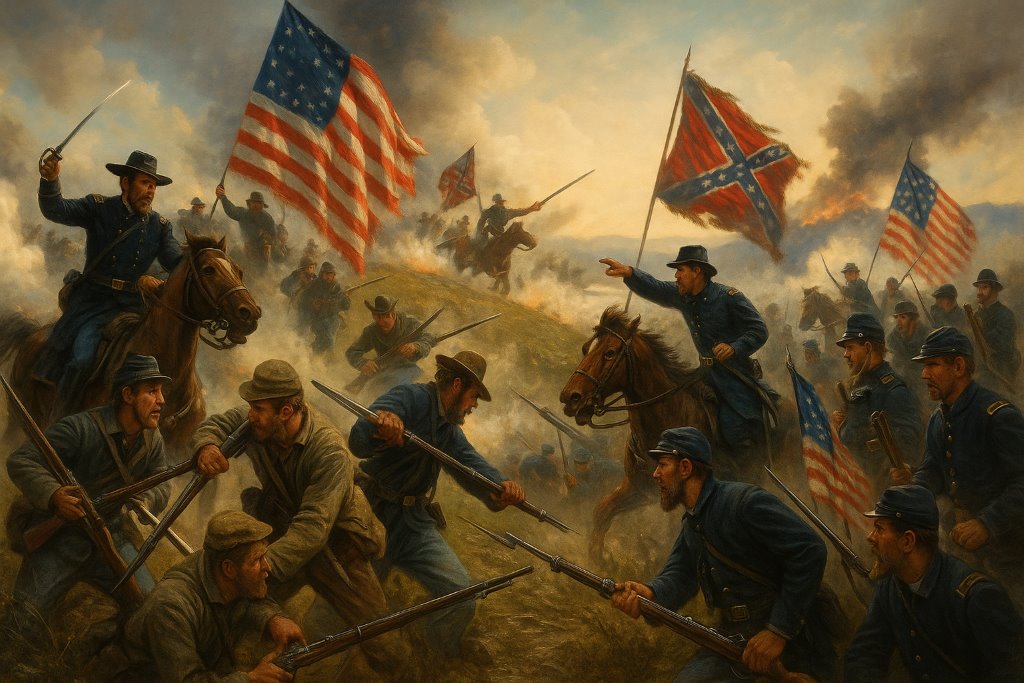
10 Most Important Battles of the Civil War (and Why They Mattered)
The Civil War was the blood-soaked heart of the nineteenth century United States. Brother against brother is more than a phrase – it was the reality in fields from Virginia to Mississippi. Over six hundred thousand lives ended, and the rest of the country carried scars that never fully faded. To look at the 10 most important battles of the Civil War is to follow the thread of the war itself, from the opening cannon fire in Charleston to the quiet surrender in a courthouse in Virginia. These were the moments when the war bent in one direction or another, sometimes suddenly, sometimes slowly. I think that’s why they stay in memory. When lists are made of famous Civil War battles, the names are familiar – Gettysburg, Antietam, Vicksburg – but each one carried its own weight, and each reshaped the future of the country.
Criteria for Selecting the Most Important Battles
Not every clash can be counted among the major battles of the Civil War. Some left fields covered in bodies but shifted nothing. Others, smaller in size, turned tides through politics or morale. To shape this ranking, three measures felt most steady. First is cost: men lost, towns ruined, families broken. Second is strategy: whether the outcome shifted rivers, rail lines, or supply chains. Third is what followed: speeches that altered policy, elections decided, even foreign powers watching with cautious interest.
These ten battles combine those elements. They’re not just the bloodiest, though many rank near the top in casualties. They’re also the fights that broke illusions, changed leadership, or forced new strategies. Some became symbols for generations – Gettysburg’s fields, Antietam’s bridge, Shiloh’s woods. Together they form a list that explains why the war lasted four years and why its outcome could never be half-measure compromise. They show what made the conflict total, and why each side fought on despite loss after loss.
The 10 Most Important Battles of the Civil War
Battle of Fort Sumter (April 1861)

The first battle of the Civil War was fought in Charleston Harbor, and although no men died in direct combat, its consequences carried weight far beyond numbers. Confederate guns opened fire before dawn on April 12, pounding the Union fort with over 3,000 shells in thirty-four hours. The Union garrison, fewer than 90 men, finally surrendered. While casualties were almost nonexistent – one accidental explosion during the evacuation killed a Union soldier – the aftermath was explosive in another way. Lincoln called for 75,000 volunteers, and within days, more than 100,000 men enlisted. Border states were forced to declare loyalty. The brief cannonade turned into a political earthquake, shifting the United States from uneasy negotiation into four years of total war.
First Battle of Bull Run (Manassas, July 1861)
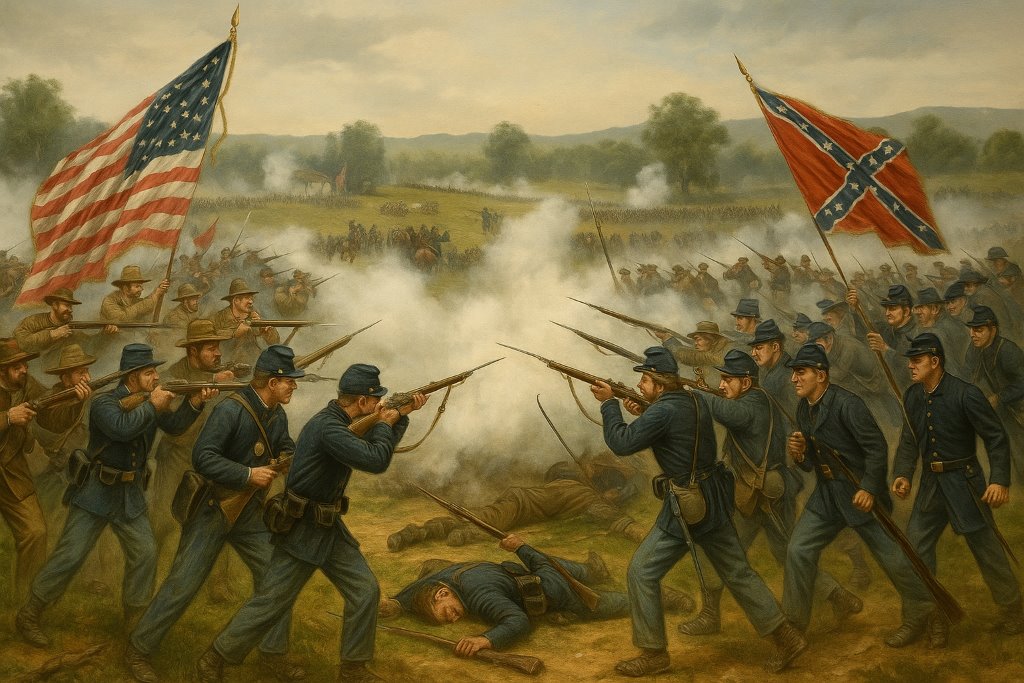
The first large-scale clash of the war showed how unprepared both sides were. Nearly 35,000 Union troops under General McDowell advanced toward 32,000 Confederates under Beauregard and Johnston. At first, Union forces pushed the Confederates back, but timely reinforcements and Jackson’s stubborn defense on Henry House Hill turned the tide. By evening, the Union army was fleeing toward Washington, leaving behind cannons and supplies. Casualties reached about 4,700 in one day – 2,950 Union and 1,750 Confederate. For the North, the loss was a national shock. The belief that the rebellion could be crushed quickly collapsed. For the South, the victory built dangerous confidence that the war could be won. Both armies realized they faced a conflict of endurance, not a quick duel.
Battle of Shiloh (April 1862)
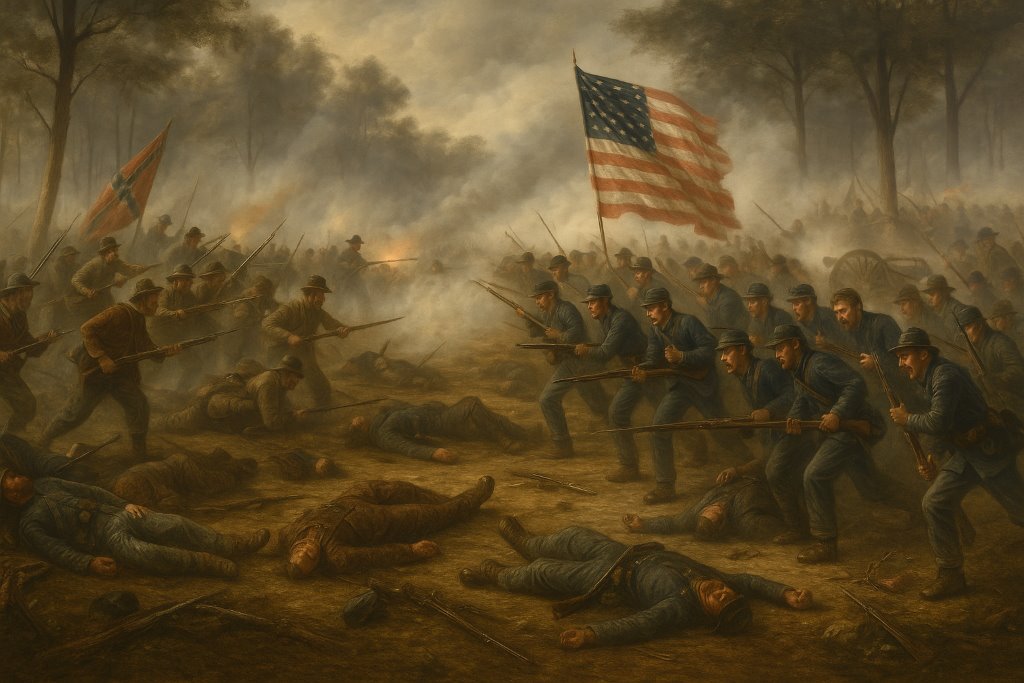
At Pittsburg Landing, Grant’s Union army of 40,000 was surprised by nearly 45,000 Confederates under Johnston and Beauregard. The first day saw heavy Union losses as Confederates drove them back toward the river. Johnston was mortally wounded, weakening Confederate leadership. Overnight, Union reinforcements swelled Grant’s force to over 55,000. The next day, the Union counterattack pushed Confederates off the field. Casualties totaled more than 23,700 – around 13,000 Union and 10,700 Confederate – more than all previous American wars combined. The shock forced both governments to accept the war’s brutality. Shiloh also secured Union control of western Tennessee, opening the road toward Corinth and the Mississippi. Grant’s determination, criticized for the slaughter, set the tone for his future campaigns: relentless and unwilling to retreat.
Battle of Antietam (September 1862)
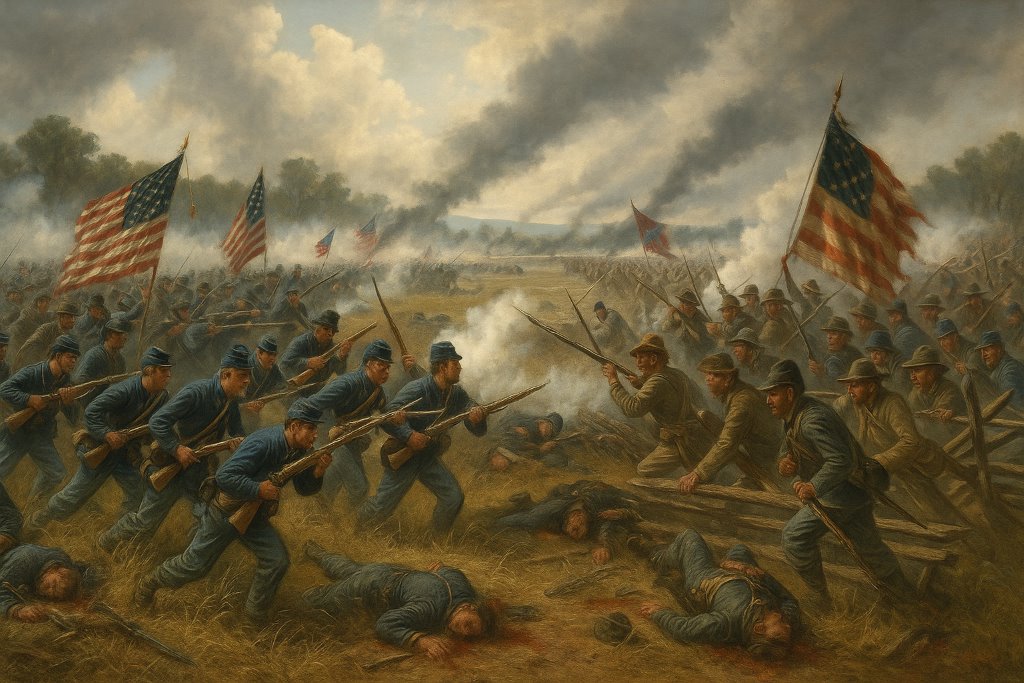
Fought near Sharpsburg, Maryland, Antietam brought together 87,000 Union troops under McClellan against 38,000 Confederates under Lee. Fighting raged from dawn to dusk – the Cornfield saw brigades wiped out within minutes, the Sunken Road became a charnel ground, and the fight for Burnside’s Bridge dragged on for hours. Casualties reached more than 22,700: 12,400 Union and 10,300 Confederate. Although tactically a stalemate, Lee’s retreat allowed Lincoln to claim victory. It was enough to issue the Emancipation Proclamation, shifting the war’s purpose toward ending slavery. The battle also kept Britain and France from recognizing the Confederacy. In one day, Antietam linked battlefield sacrifice to political transformation and ensured the war would be remembered as a fight for freedom as well as union.
Battle of Fredericksburg (December 1862)
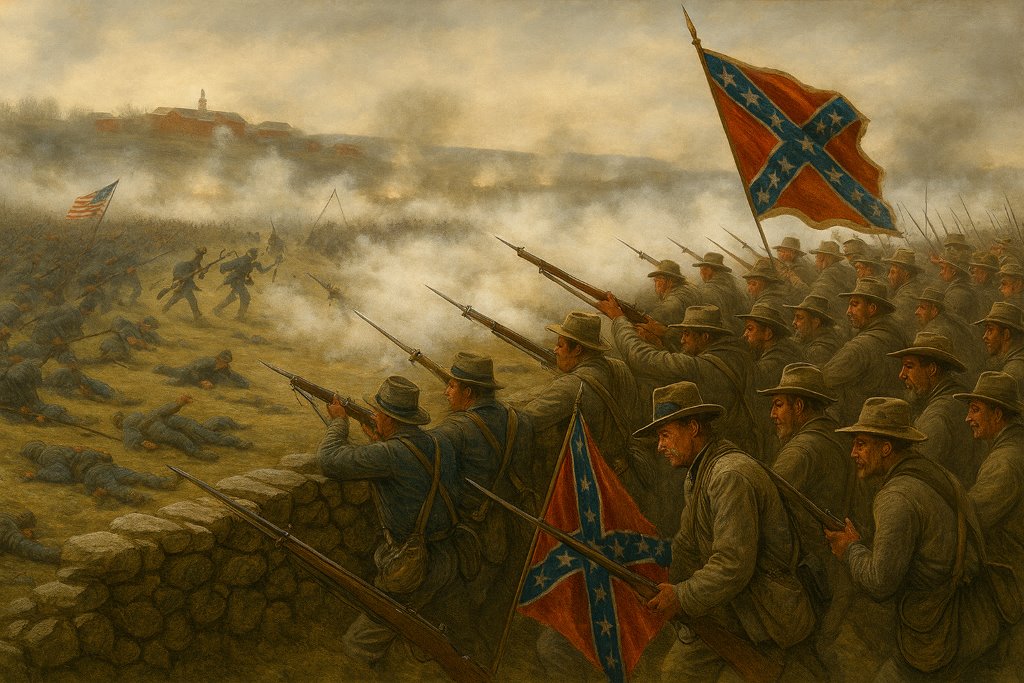
Fredericksburg displayed the futility of poor strategy. Burnside commanded 120,000 Union troops against 78,000 Confederates under Lee. On December 13, Union soldiers made repeated frontal assaults against fortified positions on Marye’s Heights. Confederate fire tore through each wave. Casualties were appalling: about 12,600 Union and 5,300 Confederate. Observers wrote of thousands of bodies lying in lines where they had fallen. The battle crushed Union morale and gave Lee one of his easiest victories. The burning of the town itself added to the devastation. Politically, Fredericksburg deepened Northern frustration with leadership and left the army demoralized as winter set in.
Battle of Chancellorsville (May 1863)
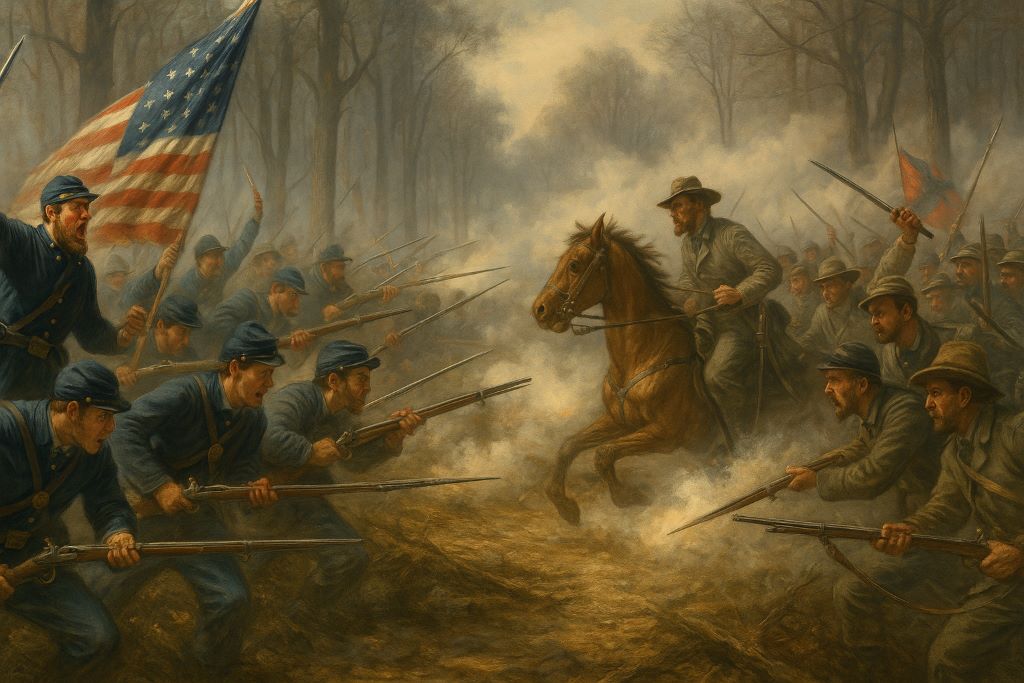
In Virginia’s wilderness, Lee faced Hooker’s Union army of 133,000 with only 60,000 men. In a daring move, he split his force and sent 28,000 men under Jackson on a 12-mile flanking march. The surprise crushed the Union right flank. The battle ended with a Confederate victory, but at a price: Jackson was mortally wounded by friendly fire. Casualties totaled nearly 30,000: 17,000 Union and 13,000 Confederate. Chancellorsville is remembered both for Lee’s brilliance and the Confederacy’s loss of its most gifted lieutenant. The win encouraged Lee to invade the North, setting the stage for Gettysburg. Yet the loss of Jackson weakened Confederate command just when it was needed most.
Battle of Gettysburg (July 1863)

Gettysburg stands as the bloodiest clash of the war and one of the famous Civil War battles most etched into national memory. Over three days, Union forces under Meade (about 93,000) fought Confederate forces under Lee (about 71,000). Day one saw Confederate advances. Day two brought desperate Union defense at Little Round Top and the Wheatfield. Day three climaxed with Pickett’s Charge, when 12,500 Confederates crossed open ground into Union fire, leaving over half their number dead or wounded. Casualties totaled around 51,000 combined: 23,000 Union and 28,000 Confederate. Gettysburg stopped Lee’s invasion and marked the Confederacy’s high-water mark. Lincoln’s Gettysburg Address months later turned the field into a symbol of sacrifice and a call for a “new birth of freedom.”
Siege of Vicksburg (May–July 1863)
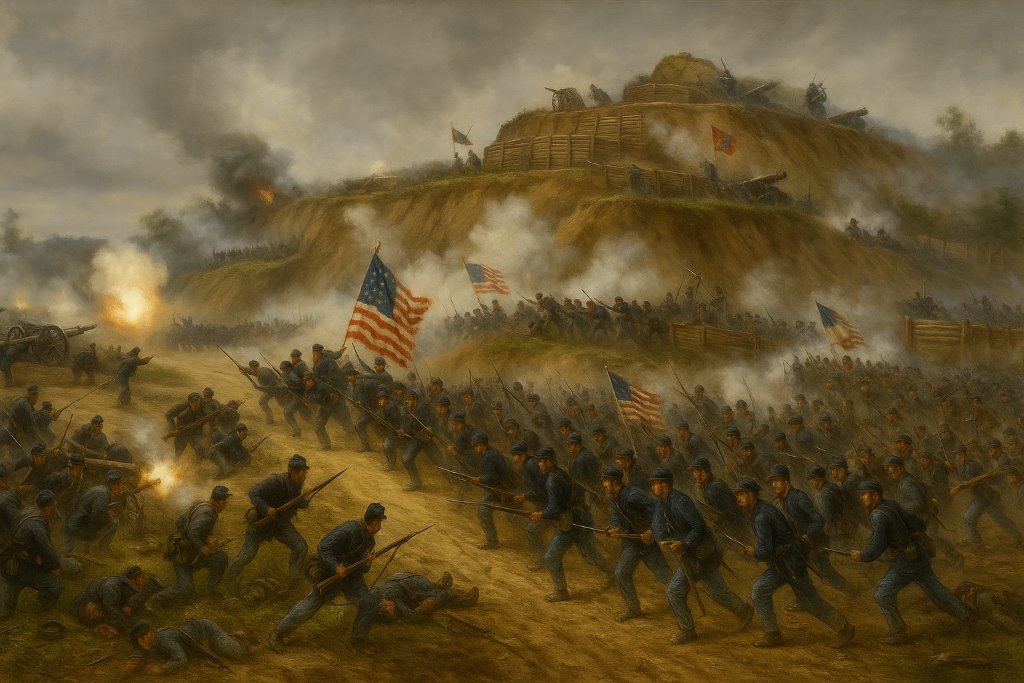
While Gettysburg dominated the East, Vicksburg decided the West. Grant’s 77,000 Union troops encircled the city, defended by 33,000 Confederates under Pemberton. For 47 days, the city endured constant bombardment. Civilians lived in caves to escape shelling, eating mules and rats as food ran out. On July 4, 1863, the garrison surrendered, giving up nearly 29,000 men and enormous supplies. Union control of the Mississippi split the Confederacy in half, cutting off Texas, Louisiana, and Arkansas. Combined casualties reached about 37,000, including surrendered soldiers. The fall of Vicksburg, just a day after Gettysburg ended, marked the true turning point of the war. Geography and persistence delivered victory where open battle might have failed.
Battle of Atlanta (July 1864)
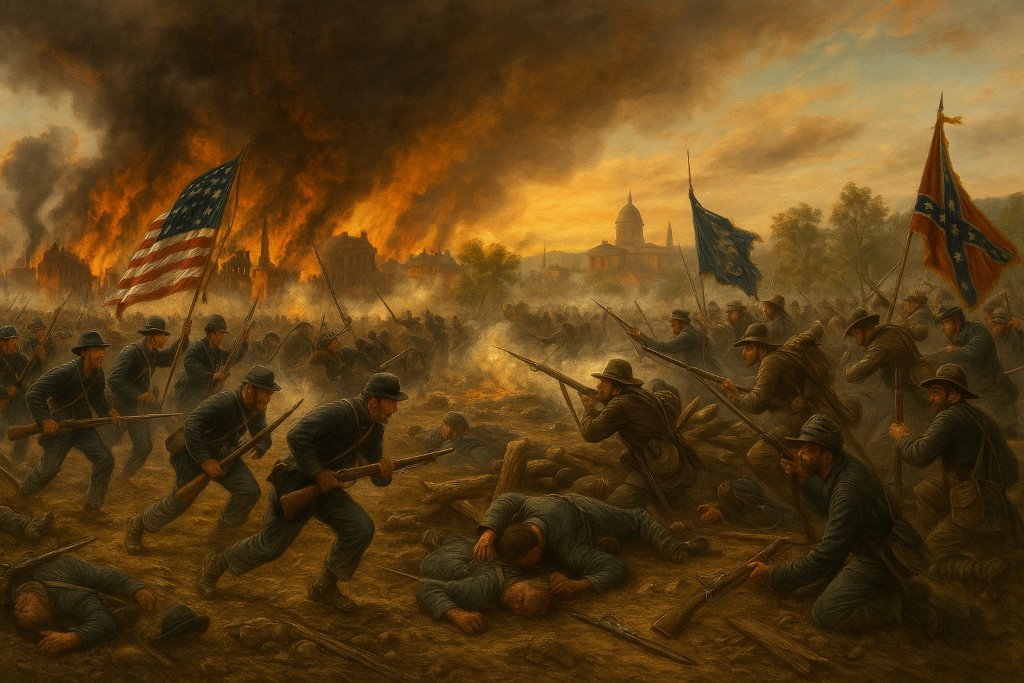
Atlanta was defended by 37,000 Confederates under Hood against 80,000 Union troops under Sherman. The city’s fall on July 22, after weeks of fighting, dealt a crippling blow to Confederate industry and morale. About 12,100 casualties resulted: 8,500 Confederate and 3,600 Union. The victory resonated far beyond Georgia. In the North, it secured Lincoln’s reelection by showing progress in the war. Politically, it killed any chance for a negotiated peace. Militarily, it opened the path for Sherman’s March to the Sea, spreading destruction across Georgia and further weakening the Confederacy’s will to fight.
Appomattox Court House (April 1865)
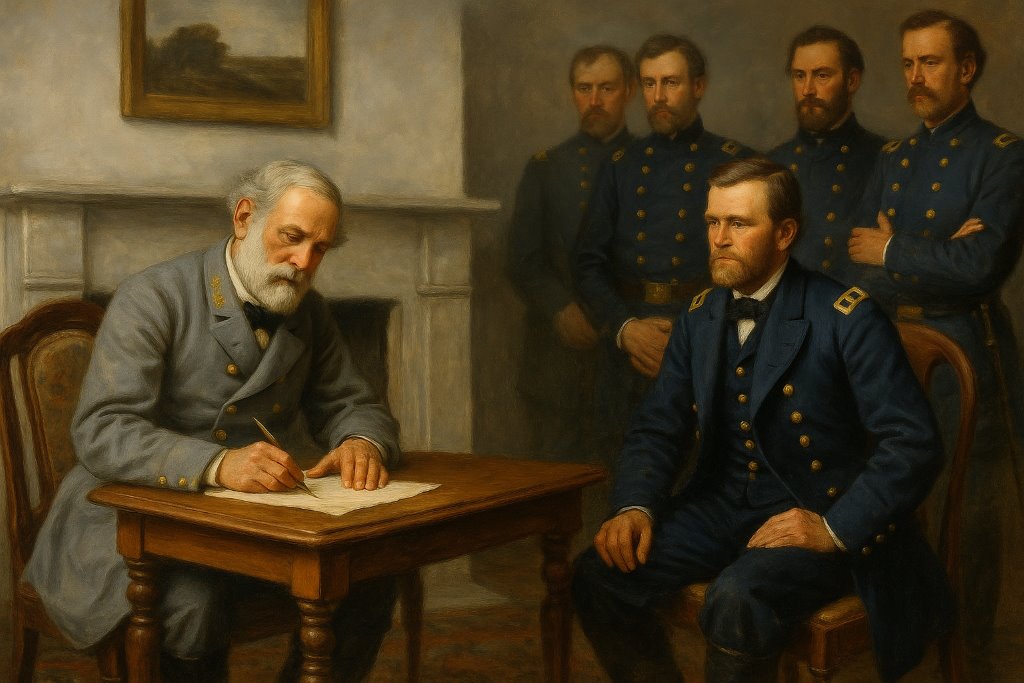
By April 1865, Lee’s once-mighty army was reduced to about 30,000 starving men, facing Grant’s 120,000. After a failed breakout attempt, Lee accepted the inevitable. On April 9, he surrendered at Appomattox Court House. The actual clash that morning caused about 700 combined casualties, small compared to earlier battles. Yet the meaning was vast. For the question who won American Civil War, the moment gave the final answer: the Union. Grant’s terms were lenient – Confederate soldiers could return home with horses, officers kept sidearms. More than 28,000 Confederates laid down arms, ending four years of war. The signatures inside a small house in Virginia symbolized reunion, even as Reconstruction would prove the peace far more complicated.
Why These Battles Were the Turning Points
Looking at all ten together, each shifted the arc of the war in some way. The most important battle of the Civil War is debated: Gettysburg for its scale, Antietam for its political consequences, Vicksburg for its strategic blow. Early battles like Bull Run and Fredericksburg showed Union weakness, while Shiloh revealed the war’s true cost. Chancellorsville proved Southern daring but also exposed how fragile their leadership was. Gettysburg and Vicksburg, arriving within a day of each other, reversed momentum. Atlanta secured Lincoln’s reelection, ensuring the war would not end in stalemate. Appomattox closed the conflict.
The numbers underscore the toll. The war left about 620,000 dead. Of these, how many Confederate casualties during the war is estimated near 260,000. Gettysburg’s 51,000 casualties in three days, Antietam’s 22,700 in one, Shiloh’s 23,700 in two – these figures remain staggering. At Vicksburg, 29,000 men surrendered at once, stripping the Confederacy of a full army. These statistics reveal why these ten battles shaped the outcome. They were not just moments of high loss, but moments where the war’s meaning and direction shifted decisively.
Legacy of the Civil War’s Major Battles
Even now, the echoes remain. Walk through Gettysburg, and the fields are lined with monuments. Antietam’s Bloody Lane still runs quiet, but the silence carries memory. Shiloh’s woods feel ordinary until you know what happened there. These battles became more than history. They turned into lessons. When asked why is the Civil War important, one answer is that these fields decided whether the United States would survive, whether slavery would end, and what kind of nation would rise from the ashes.
The legacy also shaped politics. Lincoln’s Gettysburg Address framed freedom in new terms. Grant’s restraint at Appomattox set a tone of reconciliation, even if the years after were anything but peaceful. Each site became a marker not just of war but of identity, a way for future generations to understand what division costs and what unity demands.
Conclusion
The 10 most important battles of the Civil War are more than a sequence of names and dates. They explain how a nation fractured, how it endured, and how it was reshaped by fire and loss. From the opening shells at Fort Sumter to Lee’s surrender at Appomattox, each clash left scars that turned into lessons. They remind us of the cost of division and the resilience needed to preserve unity.
When you look at casualty figures from Gettysburg, Antietam, or Shiloh, it is hard not to compare them with the deadliest battles in history across the world. The Civil War fits into a larger story of human conflict where numbers alone tell only part of the suffering. At the same time, not every trace of the past is measured in blood. Some stories survive because they are unusual, even strange, and they show that history has odd corners as well. If that side interests you, see this collection of weird historical facts that remind us the past was never as simple as textbooks suggest.


